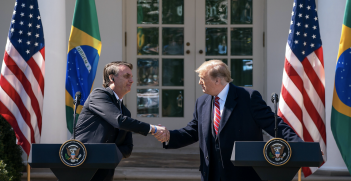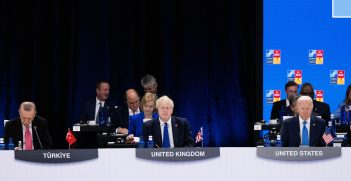The Future of Arms Control: What Follows the End of New START?

With the treaty set to expire in 2026, the absence of a binding arms control agreement raises concerns over unchecked nuclear expansion amid rising geopolitical tensions. While confidence-building measures could pave the way for future negotiations, the lack of political will on both sides signals a bleak outlook for global arms control
The New Strategic Arms Reduction Treaty (New START), the last remaining binding bilateral arms control treaty between the United States and Russia with no clause for further extension, is bound to expire on 5 February 2026. As the Treaty nears its expiration, strategic experts are questioning what will follow in the absence of a binding agreement to limit the expansion of the arsenals of world powers. The post-New START outlook for global arms control, fuelled by rising geopolitical tensions and growing mistrust between Russia and the US, looks bleak. The increased reliance of both American and Russian leadership on nuclear saber-rattling for settling disputes, accompanied by a complete lack of official arms control discussions, is a reminder of how uncertain the future of arms control has become. A move toward Confidence Building Measures (CMBs) is essential to tone down hostilities and lay the groundwork for future arms control talks. This first step can begin with ending the Ukrainian War, which US President Donald Trump has already promised to bring about.
The situation is alarming because unlike the 1968 Nuclear Non-Proliferation Treaty (NPT) and the 1987 Intermediate-Range Nuclear Forces Treaty (INF), the New START cannot be extended further beyond 5 February 2026 because the Treaty has one time extension clause of five years. New START was initially set for ten years, beginning in 2011, with one five-year extension that was utilized in 2021 during the former Biden administration. Then US Secretary of State Antony Blinken emphasised the importance of mutual compliance with the Treaty for global security, arms control, and stability.
Both states can continue to extend the New START verification provisions (like inspections and notifications) after the agreement expires. Although this provision can keep them informed about each other’s strategic modernisation programs, the arrangement may not prove effective in the long run due to a lack of a legally binding agreement. Without a binding agreement, neither state is likely to exchange classified nuclear weapons-related information through notifications or data declarations, nor would they agree to host military inspectors at each other’s bases.
A comprehensive and legally binding arms control treaty as a successor to New START can be the only solution at present, nevertheless, any such development is considered highly unlikely. A new treaty requires political will on the part of both leaderships, as well as engaging in arms reduction talks. For instance, when the New START agreement was signed in 2010, President Barack Obama and his Russian counterpart, President Dmitry Medvedev, had shown mutual willingness to replace the first START Treaty, which had expired in 2009. Additionally, the Treaty received approval from the US Senate through a decisive bipartisan vote, with the Russian parliament following in 2011, by giving its consent. This time around, arms control does not appear as a top-priority of the new US administration under President Donald Trump, nor is it a priority for Russia in the present strategic environment.
New voices emerging from US policy quarters also hint at the likely expansion of the US nuclear program with “additional deployed warheads on the land, sea and air legs that could offer national leadership increased flexibility, if desired, and executed.” This is in addition to Vladimir Putin suspending Russia’s participation in the New START Treaty on 21 February 2023, influenced by geopolitical tensions and Russia’s strategic concerns followed by his warning to the West through a new nuclear doctrine in November 2024. Vladimir Putin’s updated nuclear doctrine lowered the threshold for a nuclear strike by Moscow, indicating that even North Atlantic Treaty Organization (NATO) countries could be targeted if they provide Ukraine with conventional weapons against Russia. This update followed news of Ukraine striking deep inside Russian territory with US-made ATACMS missiles.
In a statement by the foreign ministry, Russia expressed concerns about the Treaty’s implementation and accused the US of creating unilateral advantages for getting access to Russian strategic facilities without given access to the US facilities as agreed under the New START. It also accused the US of breaching the New START Treaty through a hostile policy aimed at jeopardising Russian security, particularly in the ongoing Ukraine crisis. Key grievances include the US violating New START principles, pursuing a “strategic defeat” of Russia, expanding NATO’s nuclear infrastructure, developing missile defence systems against treaty terms, and unilaterally withdrawing over 100 units from treaty accountability. These actions are seen as threats to Russia’s national security and as violations of mutual trust and security under the New START treaty.
The actions and decisions of leaders from both sides have significantly impacted the current status of the New START Treaty and its future prospects. The statements reflect a broader strategic maneuvering. Both nations appear to be using the New START Treaty as a diplomatic tool to further their respective geopolitical agendas. Russia’s suspension of the Treaty, to be sure, is detrimental to the future of nuclear arms control, and has led to the breakdown of cooperation and communication between the two states. The US accuses Russia of non-compliance and for refusing to allow its inspections of Russian nuclear deployments.
The newly elected Trump has pledged to end the war in Ukraine, and if successful, this could serve as an important initial step towards creating the CBMs needed to foster trust in future arms control negotiations. Unfortunately, the uncertainty regarding the renewal of the New START treaty is an indicator of a broader problem, which is the general deterioration of global arms control regime over the years. Trump’s return will further impact the slow down of global arms control efforts. Currently, he does not believe in collective cooperation on arms control measures.
Despite the challenges, there is still hope for a New START 2.0, and both sides have hinted towards dialogue in the future. If not a New START, the US and Russia could restart constructive negotiations over a new bilateral nuclear arms control treaty that address major challenges and apprehensions of both parties. A new framework for arms control could also include emerging threats and disrupting technologies. This will require political will and a commitment to dialogue from both sides.
Dr Anum Riaz Associate Director Research Center for International Strategic Studies (CISS), and Mobeen Jafar Mir is a Research Officer at CISS, Islamabad.
This article is published under a Creative Commons License and may be republished with attribution.





